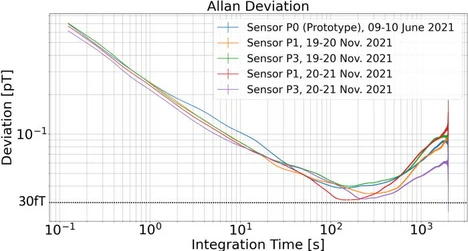Drift-stable Cesium Magnetometer
Overview
In our drift-stable cesium magnetometer project, we aim to build a robust, long-term stable all-optical cesium sensor, optimized for use in precision experiments such as neutron EDM searches. The device is designed to maintain minimal drift over extended periods while providing high sensitivity and minimal interference, critical for monitoring applied and residual magnetic fields and gradients in ultra-precise-field environments.
Scientific Motivation
Precision experiments, especially those searching for an electric dipole moment (EDM), require exquisite control and knowledge of magnetic fields. Any unaccounted drift or gradient in the magnetic field can mimic or mask the tiny signals being sought. In particular, the neutron EDM experiment at the Institute Laue–Langevin (ILL) plans to deploy an array of cesium magnetometers around the storage chamber to monitor and correct for spatial and temporal variations.
By developing a drift-stable cesium sensor, which does not introduce additional magnetic disturbance (no electrical cabling, only optical pumping and readout), we can push systematic uncertainties in field control to the femtotesla level and support ultra-precision measurement campaigns.
Methods & Experimental Setup
- The sensor uses a cesium vapor cell coated (e.g. with paraffin or silane) to reduce wall relaxation, coupled with optical pumping and probing using lasers.
- Modulation techniques and compensation schemes (e.g., dual-beam or balanced detection) are employed to suppress optical and light-shift noise.
- Because no electrical wires are needed for the sensor output, the magnetometer avoids introducing stray magnetic noise.
- Multiple sensors will be arranged in an array configuration (up to 32 heads) around the neutron storage chamber, allowing spatial resolution of multipole field perturbations and gradient mapping.
- For drift characterization, the sensors operate inside our magnetically shielded room (MSR), comparing long-term stability, thermal coupling, aging effects, and light-shift contributions.
Results, Status & Goals
- In early characterization runs, the sensor array achieved a sensitivity of ≈ 40 fT/√Hz, demonstrating the viability of the optical design for low-noise operation.
- Current in-house build sensor is one of the most stable and sensitiv sensors of its type, reaching stabilities of 35 fT in the minute range with systematically clean sensors and virtually crosstalk-free array operation
- The goal is to deliver a stable sensor network whose performance enables field monitoring and corrections at levels below potential EDM signal thresholds.
Contact / Links
For collaboration, thesis opportunities, or further inquiries, please contact:
M.Sc. Philipp Wunderl
- Tel.: +49 (89) 289 - 51327, 53716
- Raum: 5117.02.304
- philipp.wunderl@tum.de
Publications and finished Theses
- Rosner, M. et al., “A highly drift-stable atomic magnetometer for fundamental physics experiments”, Appl. Phys. Lett. 120, 161102 (2022)
Involved persons and alumni
Currently Involved persons: Philipp Wunderl
Alumni: Dr. Martin Rosner, Dr. Michael Sturm

